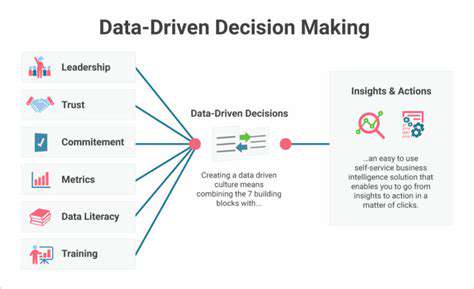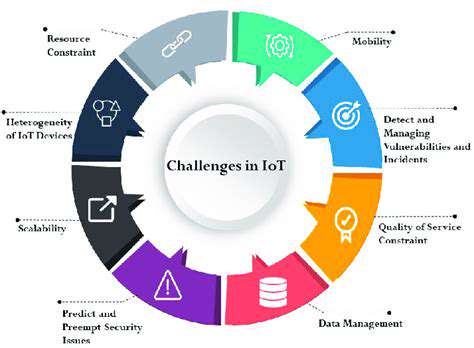Smart Greenhouses: Creating Controlled Environments for Optimal Growth
Advanced Climate Control Systems in Smart Greenhouses
Smart greenhouses utilize sophisticated climate control systems that automatically adjust temperature, humidity, and ventilation to create optimal growing conditions for plants. These systems rely on sensors to continuously monitor environmental parameters, ensuring precise regulation that adapts to the specific needs of different crops. By maintaining consistent conditions, farmers can significantly reduce stress on plants and improve overall yield quality.
Implementing advanced climate control not only enhances plant growth but also conserves energy by optimizing the operation of heating, cooling, and lighting systems. IoT-enabled controllers can predict environmental changes and respond proactively, minimizing resource wastage. This integration of technology results in a sustainable agricultural practice that supports high productivity while reducing environmental impact.
Integration of IoT Sensors for Real-Time Monitoring
IoT sensors form the backbone of smart greenhouse systems, providing real-time data on soil moisture, temperature, light intensity, and CO2 levels. These sensors are strategically placed throughout the greenhouse to gather comprehensive environmental information, which is then transmitted to centralized control units for analysis. Continuous monitoring allows for immediate detection of anomalies, enabling quick corrective actions that prevent crop stress or damage.
With the data collected, farmers can make informed decisions about irrigation, fertilization, and pest control, tailored precisely to the current conditions. The ability to monitor multiple parameters simultaneously ensures that the plants receive exactly what they need at the right time, fostering healthier growth and higher yields.
Automation and Remote Management of Greenhouse Operations
Automation in smart greenhouses allows for the seamless operation of various functions such as watering, shading, and ventilation without manual intervention. IoT systems can be programmed to perform routine tasks based on sensor data, reducing labor costs and human error. Remote management capabilities enable farmers to oversee greenhouse conditions via smartphones or computers from any location, providing flexibility and peace of mind.
This level of automation not only streamlines daily operations but also facilitates rapid response to environmental changes or system malfunctions. As a result, farmers can optimize crop growth cycles, improve resource efficiency, and ensure consistent product quality regardless of external weather conditions.
Data Analytics for Precision Agriculture
The vast amount of data collected through IoT devices in smart greenhouses enables advanced analytics that transform raw information into actionable insights. By analyzing trends and patterns, farmers can predict plant growth behaviors, optimize resource allocation, and implement targeted interventions. Data-driven decisions lead to more precise farming practices, reducing waste and increasing profitability.
Moreover, integrating data analytics with machine learning algorithms can help forecast future environmental conditions and crop yields, supporting strategic planning. This intelligent approach to agriculture ensures sustainable practices that maximize productivity while minimizing environmental footprint.
Challenges and Future Trends in IoT-Driven Greenhouse Technology
Despite the numerous benefits, implementing IoT in greenhouses presents challenges such as high initial costs, data security concerns, and the need for technical expertise. Ensuring interoperability among different devices and maintaining system reliability are ongoing issues that require careful planning and management. Additionally, farmers must stay updated with rapidly evolving technologies to fully leverage IoT capabilities.
Looking ahead, future trends include the integration of artificial intelligence for predictive analytics, the use of renewable energy sources to power IoT systems, and the development of more affordable sensor technologies. These innovations promise to make smart greenhouses even more efficient, accessible, and sustainable, revolutionizing the future of controlled-environment agriculture.
Advanced Crop Monitoring: Real-Time Data for Better Decision-Making

Real-Time Data Acquisition
Advanced crop monitoring relies heavily on the ability to collect data in real-time. This allows for immediate analysis and response to emerging issues, such as disease outbreaks or sudden weather changes. The speed and accuracy of this data acquisition are crucial for effective decision-making in agriculture, enabling farmers to make timely adjustments to their practices and ultimately improve yields and minimize losses.
Various technologies, including remote sensing and sensor networks, are employed to gather real-time data on crop health, environmental conditions, and other relevant factors. These technologies provide a comprehensive view of the field, allowing for detailed analysis of specific areas and enabling proactive interventions.
Predictive Analytics for Crop Health
Beyond simply collecting data, advanced crop monitoring integrates predictive analytics to forecast potential issues. By analyzing historical data, current conditions, and weather patterns, sophisticated algorithms can predict future crop health and yield outcomes. This allows farmers to proactively address potential problems before they impact the crop. This approach is crucial for minimizing risks and maximizing efficiency in agricultural operations.
Precision Irrigation and Fertilizer Application
Real-time data enables precision irrigation and fertilizer application. Sensors can monitor soil moisture levels and nutrient content in real time, allowing farmers to deliver water and nutrients precisely where and when they are needed. This minimizes waste and optimizes resource utilization, reducing environmental impact and improving profitability.
Precision agriculture practices, supported by real-time data, are becoming increasingly important for sustainable farming. By targeting resources effectively, farmers can significantly reduce their environmental footprint while maintaining high yields.
Remote Sensing and Drone Technology
Remote sensing technologies, such as satellite imagery and aerial photography, play a vital role in advanced crop monitoring. These technologies provide a bird's-eye view of the entire field, enabling farmers to identify areas with specific issues, such as nutrient deficiencies or pest infestations. This allows for targeted interventions, maximizing efficiency and minimizing the use of broad-spectrum treatments.
Improved Crop Yield and Reduced Waste
The ultimate goal of advanced crop monitoring is to improve crop yield and reduce waste. By identifying and addressing issues early, farmers can enhance the health and productivity of their crops, leading to higher yields and reduced losses. This not only benefits the farmer financially but also contributes to food security on a global scale. Real-time data analysis and proactive management practices are critical for achieving these outcomes.
Protein is an essential macronutrient that plays a crucial role in building and repairing tissues throughout the body. It is involved in the formation of enzymes, hormones, and other vital molecules that sustain life. Consuming adequate amounts of protein supports muscle maintenance, especially for athletes and individuals engaged in regular physical activity.
Benefits and Challenges of Implementing IoT in Agriculture

Implementation Benefits
Implementing new systems, processes, or technologies can yield numerous advantages, from increased efficiency and productivity to improved customer satisfaction and brand reputation. A well-executed implementation can streamline workflows, reducing errors and wasted time. This leads to significant cost savings in the long run, while also fostering a more positive and engaged workforce. The improved processes often lead to increased output and better quality results.
Furthermore, successful implementations can open doors to new opportunities, such as expanding market reach or developing innovative products and services. These expansions can propel growth and profitability, strengthening the organization's position in the competitive landscape. The benefits extend beyond the immediate gains, often impacting the long-term sustainability and resilience of the organization.
Technological Advancements
Technological advancements play a crucial role in the modern business landscape. Implementing new technologies can significantly enhance operational efficiency, enabling businesses to automate tasks, analyze data more effectively, and improve decision-making. These advancements can be a game-changer for businesses, especially in today's dynamic market environment. They can also lead to improved customer experiences and greater competitiveness.
Businesses need to adapt to these advancements to remain relevant and competitive. Failure to embrace technology can lead to a loss of market share and diminished profitability. The ability to quickly adopt and implement new technologies is often a critical factor in success.
Improved Operational Efficiency
Implementing new systems and processes can directly lead to improved operational efficiency. Streamlined workflows, automated tasks, and better data management contribute to reduced costs and increased productivity. This efficiency translates into significant financial gains, allowing the company to allocate resources more effectively. This can also lead to better customer service and stronger relationships with stakeholders.
Improved efficiency often results in faster turnaround times for projects and services. This, in turn, can lead to increased customer satisfaction and a stronger brand reputation. The bottom line is improved operational efficiency is a key driver of success for any organization.
Resource Allocation and Management
Effective resource allocation and management are essential for successful implementation. This involves properly identifying, securing, and deploying the necessary resources, such as personnel, budget, and technology. Careful planning and resource management are vital for a smooth and successful implementation process. This also includes considering the impact on existing resources and how new resources will integrate.
Resource allocation is not just about the tangible items; it also extends to human capital. Identifying and training the right personnel to support the implementation is critical. A well-defined resource allocation strategy is key to mitigating risks and maximizing the potential benefits.
Risk Mitigation and Management
Implementing new systems and processes inevitably involves some level of risk. Thorough risk assessment and mitigation strategies are essential to minimize potential negative consequences. This includes identifying potential issues, developing contingency plans, and establishing protocols for handling problems during the implementation phase. Proactively addressing potential problems can prevent significant setbacks. Identifying and addressing potential risks beforehand can save time and money.
Risk mitigation strategies should be embedded in the project plan from the outset to prevent costly mistakes or unforeseen consequences. This proactive approach allows for a more controlled and predictable implementation process.
Potential Challenges and Obstacles
Implementing new systems or processes can present various challenges, including resistance to change from employees, inadequate training, or insufficient resources. These challenges need to be anticipated and addressed proactively to ensure a smooth transition. Addressing these challenges early on is crucial for a successful outcome. Careful planning and communication are key to overcoming these obstacles.
Another potential challenge involves integrating new systems with existing infrastructure. Compatibility issues and data migration challenges can be significant obstacles. Addressing these challenges requires careful planning and execution to ensure a seamless integration.
The Future of IoT-Driven Agriculture
Advancements in Sensor Technology and Data Analytics
As technology continues to evolve, the integration of advanced sensors in agricultural practices is revolutionizing how farmers monitor and manage their crops. These sensors can now provide real-time data on soil moisture, nutrient levels, temperature, and humidity, enabling more precise interventions. The proliferation of low-cost, high-accuracy sensors allows for widespread deployment across large farming areas, facilitating large-scale data collection that was previously impossible.
Coupled with sophisticated data analytics and machine learning algorithms, this influx of information enables predictive modeling of crop health, pest outbreaks, and weather patterns. Farmers can make proactive decisions based on predictive insights, such as adjusting irrigation schedules or applying fertilizers more efficiently. This synergy between sensors and analytics not only enhances productivity but also promotes sustainable farming by reducing resource wastage and minimizing environmental impact.
The Role of IoT in Sustainable and Precision Agriculture
IoT-driven agriculture is paving the way towards more sustainable farming practices by optimizing resource use and reducing chemical inputs. Precision agriculture, powered by IoT devices, ensures that water, fertilizers, and pesticides are applied exactly where and when they are needed, minimizing runoff and soil degradation. This targeted approach helps conserve vital resources while maintaining high crop yields, supporting environmental conservation efforts.
Moreover, IoT-enabled systems facilitate continuous monitoring and automated adjustments, reducing the reliance on manual labor and guesswork. As a result, farmers can achieve higher efficiency and crop quality while also reducing their carbon footprint. The integration of IoT in agriculture not only secures food production for the growing global population but also contributes to the broader goals of sustainability and climate resilience in the agricultural sector.
